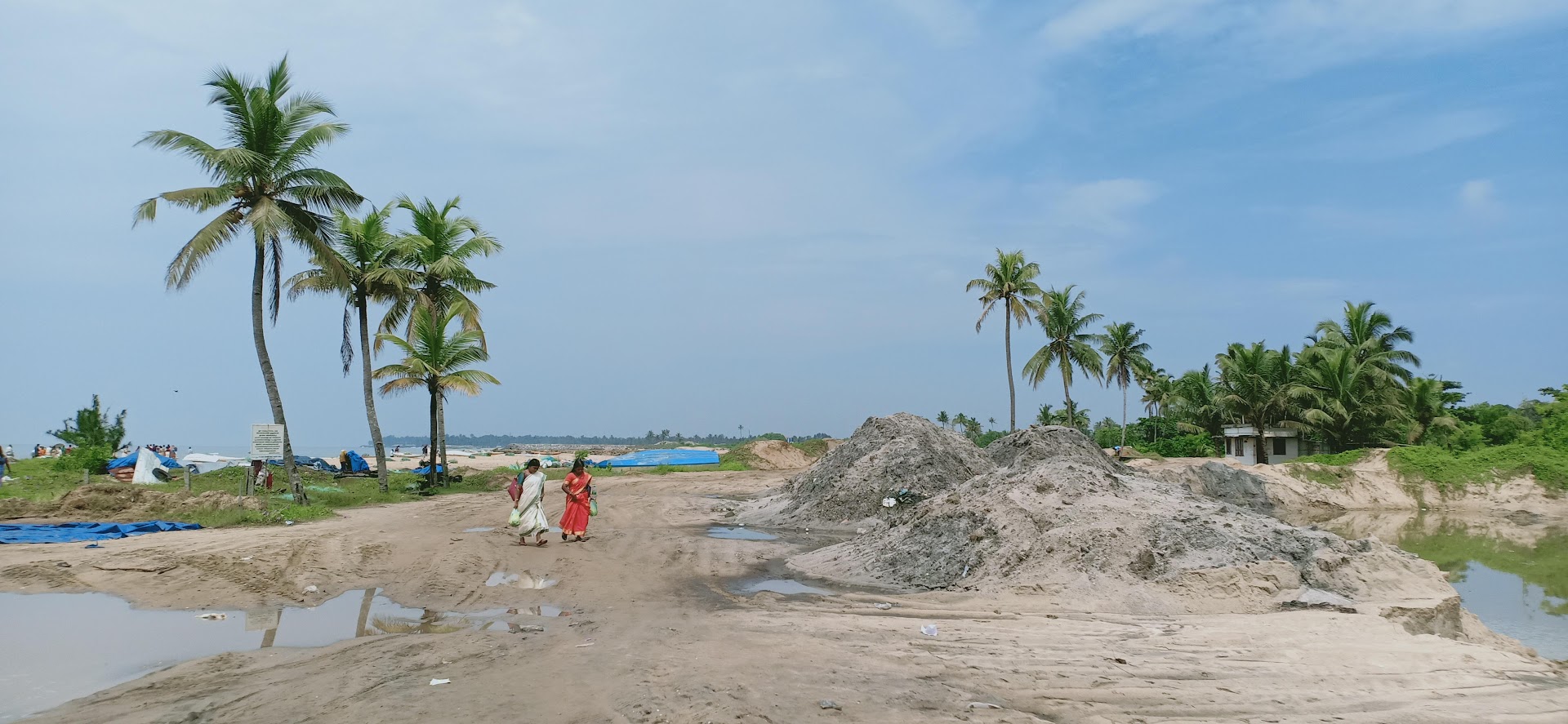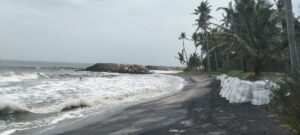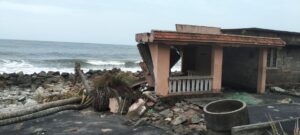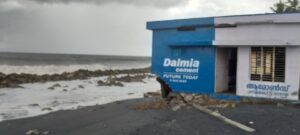Kerala is seeking the Union government's nod to establish a thorium-based nuclear plant, claiming the radioactive metal is abundant on the mineral-sand-rich Alappuzha-Kollam coast.

Mined mireal sand is kept ready for transportation at Alapad in Kollam. Photo: K A Shaji
Marking a major shift in its energy policy, Kerala’s Pinarayi Vijayan-led Left Democratic Front (LDF) government has approached the Union government for permission to establish a nuclear power plant using the rich but contentious thorium deposits available in the Alappuzha-Kollam coastal regions of the state.
The state government is yet to start a public discussion on the subject, and no consultations have been made among the alliance partners in the ruling LDF.
However, Electricity Minister K Krishnankutty raised this demand during his recent interaction with Union Power Minister RK Singh and urged the Union government to consider it a top priority to ensure energy self-sufficiency in the state.
Krishnankutty’s office confirmed to South First that the minister sought a Union government nod for such a plant, keeping in view the future power requirements of the state.
The Bhabha Atomic Research Centre (BARC) is currently running a thorium-based nuclear plant at Kalpakkam in Tamil Nadu.
The Kerala government is eyeing a similar project either in Alappuzha or Kollam, where the rare raw material is available in abundance.
The state’s priority location is Kayamkulam in Alappuzha, where a defunct thermal power station of the NTPC exists at present. The land holdings of that project can be easily converted for this purpose.
In addition to the demand for a nuclear power project, the state has also sought the Centre’s nod to mine and transport the radioactive metal thorium from the southern Kerala region to Kalpakkam to sell it to the power plant there.
The government thinks such a sale would help it gain good financial returns.
Interestingly, the state government is going forward with such a move when people’s movements are in full swing in Alappuzha and Kollam against indiscriminate mining of the local seashore sand containing the precious metal.
The local residents are raising significant questions about livelihood and environmental protection.
Wherever mining occurs, the coastal communities have the most to lose — from their houses, properties, and livelihoods to the stolen shores and the invading sea.
In addition, setting up a nuclear power plant in the high-density areas of Kollam and Alappuzha would turn disastrous in the long run.
Meanwhile, the proposal contradicts the earlier CPI(M) stand that, given its high population density, Kerala was unsafe for establishing such a huge radioactive power plant.
On the other hand, those who favour the atomic project say about 25 percent of the world’s thorium ore is available only in the southern belts of Kerala and Tamil Nadu. They say thorium has a high thermal conductivity and melting point.
In addition to the local resistance, one major hurdle in implementing the project is expected to be the opposition from powerful anti-nuclear movements in the state, which have a long history of successful resistance.
When Kerala’s Electricity Department abandoned its proposed nuclear power project at Peringome in the Kannur district during the mid-1980s, it was vaunted as the result of a collective action involving writers, artists, intellectuals, and environmentalists supported by the state’s strong Left movement.
Those were the days when the nuclear disaster at the Chernobyl nuclear power plant in the erstwhile USSR caused large-scale public concern about nuclear hazards worldwide.
The CPI(M)’s youth wing, the DYFI, and the popular pro-Left science organisation Kerala Sasthra Sahitya Parishad were at the forefront of the agitations, condemning the proposed plant and terming such proposals unsafe in a state with a high density of population.
As a result, Peringome continues to occupy a prominent place in the global history of movements against atomic plants. Many veteran activists in Kerala recall a similar kind of protest in the state in the late 1970s when the government pushed a nuclear power project at Bhoothathankettu in the Ernakulam district in proximity of the mighty Periyar river.
The success of the Save Silent Valley Movement, which stopped a hydroelectric project, served as inspiration for the movement in Bhoothathankettu.
The project would have required the eradication of an evergreen forest area in the Palakkad district and the destruction of the habitat of endangered lion-tailed macaques.
Also, the government had to backtrack from its plan, fearing large-scale public resistance.
By the time of the Fukushima nuclear disaster in 2011, anti-nuclear campaigns had won many supporters from the Left circles.

Sand bags were deployed in Thrikunnapuzha in Alappuzha to prevent sea erosion caused by the idiscriminate mining of mineral sand. Photo: K A Shaji
There were even protests in the state against the Kudamkulam atomic reactor in Tamil Nadu, saying its proximity to the southern districts of the state would spell doom for people there.
Veteran CPI(M) leader and former chief minister VS Achuthanandan became a prominent anti-nuclear campaigner.
He even attempted to visit Kudamkulam once to extend solidarity with the agitating local community.
The party’s national leadership vetoed the plan on the advice of current Chief Minister Pinarayi Vijayan, who argued that Achuthanandan’s participation in the strike would adversely affect the interests of the party in the neighbouring state.
Achuthanandan extended his solidarity online and refuelled the anti-nuclear movement in the state.

A house was lost to indiscriminate mineral sand mining in Thrikunnapuzha in Alappuzha. Photo: K A Shaji
Besides the need for a thorium-based power plant, there is also a political dimension to the situation because of the controversy surrounding Vijayan’s daughter Veena T’s IT company, Exalogic Solutions Private Limited, accepting “illegal payments” worth ₹1.72 crore from Cochin Minerals and Rutile Limited (CMRL), a company that mines and trades minerals like thorium.
The payment courted controversy since Exalogic had not provided any software service to CMRL.
After an income-tax inspection in 2019 found the alleged illegal money transactions, the CMRL case was brought before the Interim Board for Settlement by the Central Board of Taxes.

A building was destroyed in sea erosion caused by mineral sand mining in Arattupuzha. Photo: K A Shaji
The company and its managing director, SN Sasidharan Kartha, requested the settlement.
CMRL, the lone private player in mineral sand mining and segregation sector in Kerala, has been facing the wrath of coastal communities and environmentalists for a long time because of its indiscriminate mining and violation of all applicable laws.
In the mineral-rich Thottappally coastal village in Alappuzha alone, 456 houses have been destroyed due to coastal erosion since mineral sand mining began after the 2018 floods.
According to the government’s official position, only its agencies are mining the mineral sand and transporting it to either Kerala Minerals and Metals Ltd in Chavara or Indian Rare Earths Ltd in Kollam.
The rules say only public sector companies can mine and transport mineral sand deposited on the Kerala coast. No private party is allowed to mine or transport the sand.
Cochin Minerals and Rutile Limited is mining and transporting the mineral sand by engaging in a joint venture with the public-sector Kerala State Industrial Development Corporation (KSIDC).
The private company is now sourcing raw materials, including mineral sand, from public-sector extraction companies. So, the company allegedly bribes leaders of all major political parties and their close relatives.
CMRL would be the largest beneficiary once the thorium-based reactor comes up or the permission to mine and transport thorium to Kalpakkam gets approved.
If the plant materialises, many coastal villages in regions like Thottappally, Thrikkunnapuzha, Arattuvazhi, Alappad, Chavara, Kayamkulam, and Kollam would be wiped out.
Initially, the Congress, the BJP, and the CPI(M) were with the agitating coastal communities, demanding fair practices in the mining and transporting of precious metals. But later, they disappeared, as did the media focus.
A journey through the coastal roads of Kollam and Alappuzha would be enough to understand the scars of indiscriminate mining: abandoned houses, temples, schools, and seawater-inundated villages.
The water in the ponds has turned red, and wilted mangroves stand testimony to man’s greed. The situation would turn bad once the nuclear plant came up.
Going by history, the presence of the minerals thorium, ilmenite, rutile, zircon, monazite, leucoxene (brown ilmenite), sillimanite, and garnet in the coastal dunes of Kollam and Alappuzha was discovered in the 1920s, and the mining started on a large scale in the 1960s.
Indian Rare Earths Limited and Kerala Minerals and Metals Limited are extensively mining the area despite people’s protests.
Since the companies have clearances from the concerned state government departments and favourable orders from the Kerala High Court, the voices of dissent are silenced.
The government has no data on people evicted without providing compensation for their losses. No serious study has been made into the polluted drinking water sources.

May 20, 2024

May 19, 2024

May 19, 2024

May 19, 2024

May 19, 2024

May 19, 2024